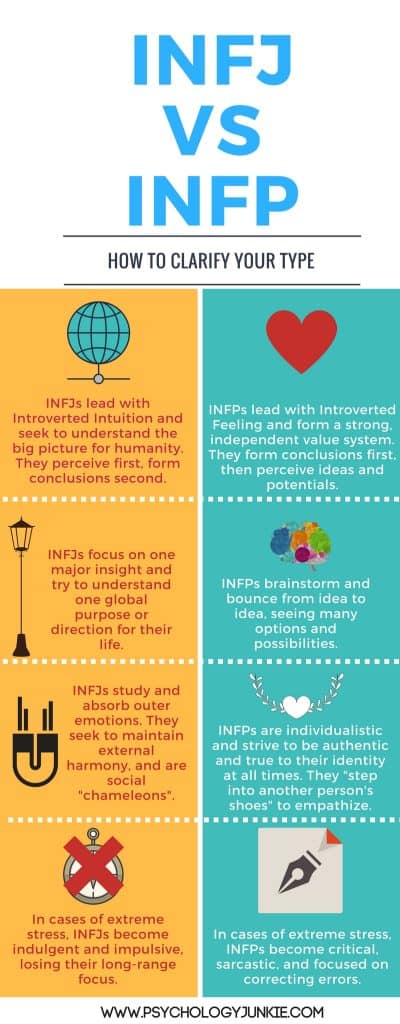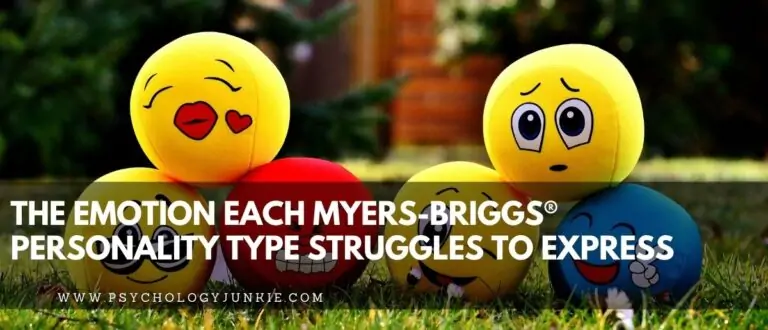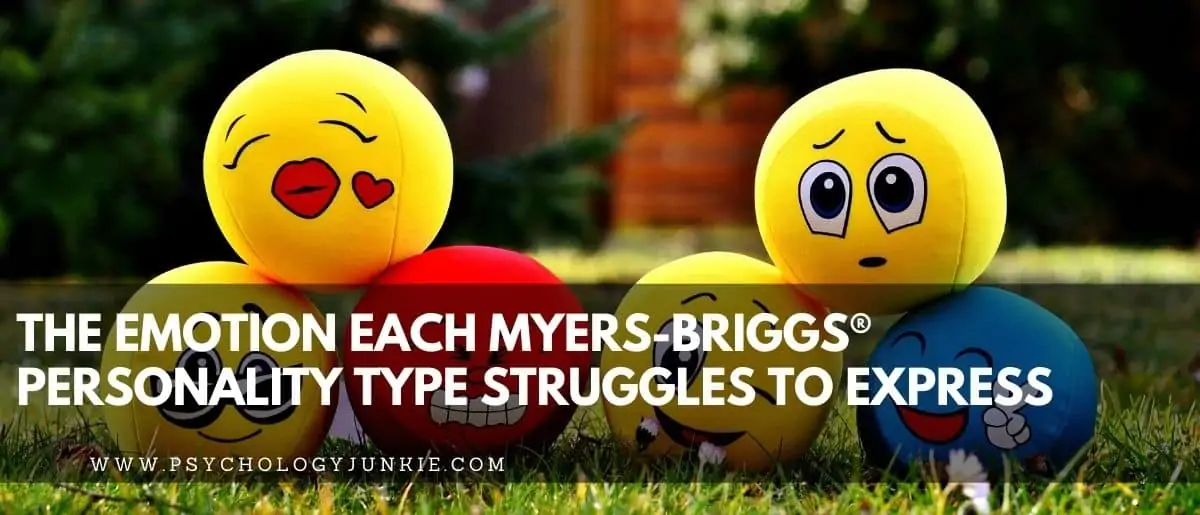Are You An INFJ or an INFP? How to Find Out!
“Am I an INFP or an INFJ?” This is a question I get every day as an MBTI® practitioner and blogger.
The reason this question comes up so frequently is because there are so many unreliable online tests out there. These knock-off personality quizzes claim to be as accurate as the official Myers-Briggs Type Indicator®, but they are lacking the reliability and validity testing that went into the official MBTI®. As a result, numerous people are being mistyped or getting different results each time they take the test. The most common mistype to come from these online tests is the INFP/INFJ mistype.

Estimated reading time: 8 minutes
Take my INFJ or INFP Test! Scroll Down After Taking the Test to Read the Rest of the Article
Why are so many INFPs and INFJs mistyped?
The majority of online tests focus on the letter dichotomies (E or I, S or N, F or T) without considering the cognitive functions. Because of this, a very slight preference towards the P dichotomy or the J dichotomy could change your entire type. This isn’t how personality typing should work.
INFJs and INFPs share zero cognitive functions. Cognitive functions are like mental tools that you have at your disposal at all times. We all use different tools more readily, and with different levels of aptitude.
Are you confused yet? Let’s try to simplify things!
Let’s start by taking a look at the different cognitive functions for the INFJ and the INFP.
INFJ Functions:

INFP Functions

If you look closely, you can see that the INFJ uses introverted intuition (Ni), extraverted feeling (Fe), introverted thinking (Ti), and extraverted sensing (Se). The INFP uses introverted feeling (Fi), extraverted intuition (Ne), introverted sensing (Si), and extraverted thinking (Te).
In short, there is not one function that these two types share.
How can I tell if I’m an INFP or an INFJ?

How INFPs and INFJs Use Intuition
INFJs lead with introverted intuition. This is their dominant function. Their #1 favorite driver. They use it so much that they probably don’t even realize they are using it.
More than anything else in the world, INFJs are going to look at patterns, perspectives, and the big picture.
They privately consider the purpose and meaning of life, and analyze human patterns and behaviors. They like to discard possibilities until they come to the one most likely possibility for the future.
For the INFJ, finding “the one” idea is the goal.
INFPs use Extraverted intuition. Rather than looking for the “one” idea, INFPs enjoy navigating dozens of ideas and possibilities. Their minds generate imaginative connections, futures, scenarios, and dreams on the fly. There’s a wish to expand possibilities rather than to narrow them down.
Unlike the INFJ, who focuses on discarding possibilities until the right one is reached, an INFP adds MORE possibilities to the picture.
They can see one thing and extrapolate numerous ideas and connections from that one thing. Brainstorming and bouncing from idea to idea is natural to them. Their intuition is like a tree with short roots but broad branches reaching out in many different directions. It has lots of breadth, and extrapolates many connections.
How INFJs and INFPs Use Feeling
INFJs use Extraverted Feeling. This is their 2nd favorite, or auxiliary function. It balances out their intuition. INFJs notice and absorb the moods and emotions of the people around them. They usually know how to alter their behavior to make everyone feel good. Smiling, laughing, getting into a “vibe” with someone else; this is something that comes naturally to them.
INFJs are often called “social chameleons” because they can so easily adjust to the people around them. In fact, some INFJs risk losing themselves in the aura of the people around them, forgetting their own individual sense of self.
For the INFJ, external harmony is key. There’s a natural tendency to adjust to others.
INFPs use Introverted Feeling (Fi). This is their favorite function, the one they use without having to try.
INFPs constantly analyze how things fit in with their value system. What feels right to them? What matters to them? What do they stand for, even when everyone else is going a different direction?
INFPs are individualistic and autonomous. They don’t want to be influenced by the external “mood”.
For the INFP, inner harmony is key. There is a natural tendency to march to the beat of their own drum and not change or “chameleon” for others.
INFPs are constantly in check with their conscience to determine if something is “right” or “wrong.” They step into other people’s shoes to try to understand how they would feel in their position. This is called “mirroring” emotions.
INFPs will rarely alter their ideals or identity to “smooth over” things in the outer environment. Internal harmony and authenticity will always be more of a priority than external harmony.
How INFJs Use Thinking
INFJs care about things making sense in their own minds. While on the outside they can seem empathetic and friendly, inside they have a more skeptical, analytical side.
For INFJs, logical consistency is important and they can easily play devil’s advocate if they’re around people who won’t take offense to it.
Categorizing and sorting out information is a lot of fun for INFJs! They enjoy understanding the principles and underlying frameworks of how ideas and theories work. They learn for the sake of learning; but they don’t typically feel comfortable “talking out” their logic with others, because they worry that it will seem critical or their thoughts won’t be refined or accurate enough.
How INFPs Use Thinking
INFPs use Extraverted Thinking, but it’s in the inferior position for them. Extraverted Thinking focuses on externalizing logic to make sense of things, or organizing the outer world to achieve a specific goal.
INFPs like the idea of to-do lists, goals, and organizing the world around them in a way that makes sense. But they tend to feel uncomfortable doing it. Instead, priority is given to the world of Feeling and Intuition; values, ideals, imagination, exploration, conviction.
As INFPs age and mature, they tend to become more proficient with Extraverted Thinking. They become more effective at giving constructive criticism, offering logical advice, or organizing their world in a productive way. But this usually takes time and practice and they will feel tired afterwards, like they’ve just expended a lot of mental energy.
During moments of stress, INFPs may fall into the grip of Extraverted Thinking and become more critical, bossy, and focused on organizing and “fixing” everything in their environment.
How INFJs Use Sensing
INFJs use a process called Extraverted Sensing, or “Se” for short. Extraverted Sensing is all about acknowledging what’s tangible and relevant, rather than trying to figure out what’s going on beneath the surface.
Because Se is inferior for INFJs, it tends to take a backseat. They can easily feel overwhelmed by noise, sights, sounds, tastes, and textures. The concrete realities of life sometimes feel suffocating, particularly when compared to the compelling world of intuition.
With age and maturity, INFJs become more proficient with Extraverted Sensing. They become more effective at handling details, reacting to spontaneous events, and enjoying the moment rather than fixating on the future.
During extreme stress, INFJs may fall into the grip of Extraverted Sensing. When this happens, they become more impulsive, pleasure-seeking, and hedonistic. They may shop carelessly, overeat, over-exercise, lose their temper, or do something else in an impulsive burst of energy that they wouldn’t normally do.
How INFPs Use Sensing
INFPs use a process called Introverted Sensing, or “Si” for short. This function is all about tuning into the past, in all its personal nuance, and using the memories to instill something significant or helpful into the present moment.
When INFPs use Introverted Sensing they reminisce, recall age-old wisdom, or revel in routines and traditions that give them a sense of groundedness.
Introverted Sensing is a valued function for INFPs. They tend to have a playful, creative, childlike energy with it. They may enjoy commemorating their memories in creative ways; through specific playlists, poetry, scrapbooking, songs, or artwork. They may also develop special feel-good routines that comfort them during difficult moments.
Receiving love and support in the world of Introverted Sensing is crucial for INFPs. It means a lot to them when others value and honor their traditions or routines or take an interest in their stories or life experiences.
What Do You Think?
I hope this helps you to understand the real differences between the INFP and INFJ! I also hope this helps you to figure out if you are one of these types. If you’re still unsure what your personality type is, you can take my INFP or INFJ questionnaire here.
Tap into even more discoveries of your personality type in our eBooks, Discovering You: Unlocking the Power of Personality Type, The INFJ – Understanding the Mystic, The INTJ – Understanding the Strategist, and The INFP – Understanding the Dreamer. You can also connect with me via Facebook, Instagram, or Twitter!

Sources:
There is a lot of helpful information about these two types if you are still seeking clarification. Check out these links!
References:
Building Blocks of Personality Type by Leona Haas and Mark Hunziker (2006, Eltanin Publishing)
Understanding Yourself and Others® An Introduction to the Personality Type Code by Linda V. Berens and Dario Nardi (InterStrength, 2004)

Get Your Free INFJ eBook
As a thank you for subscribing to my newsletter I will send you this free eBook PACKED with self-care tips, creativity hacks, and more! You'll also get a 3-day email course for understanding your personality type better!











My best friend is totally and INFP and I am totally an INFJ. No mistakes there. We are very different. No one would ever accuse us of being remotely similar, even though we are both creative, both intuitive, both introverted, I am less introverted than my INFP friend. Bang on!
It seems like I might be both somehow…. i have half the traits of INFJ and half the traits of INFP (I’m also a Gemini so it might just be the split personality thing).
I feel the exact same way and am also a Gemini, maybe you’re on to something
I am sitting here trying to determine which I most appear to be, but I too am a Gemini.
I’m a Gemini too and I have the same problem! I have to say I’ve spent weeks studying the differences and taking tests, but I swear depending on my environment/mood/state of mind and body, I act differently. The results always come out either INFP vs INFJ.
Um…both?? I’ve taken the Myers Briggs personality test several times, each time i’m either 51% Perceiving or 51% Judging. Unfortunately, I still can’t decide which because I feel like i’m both at once. :/
I CAN’T FIGURE OUT WHICH ONE I AM
One of these days I’m going to read an article on this topic that clears up my confusion. That day is not today. *sigh*
Can you be both? Like a middle-thingy? I haven’t finished reading yet, but I feel both detached from this world and as if I don’t fit with 99% of all others people. So like ultradetached or something. lol
Best, ever,
INFP Logical thinking less than INFJ.
And the other hand, inferior function is excellent definition i ever Read between those.
Thanks.
(INFJ)